
The First and Only Weekly Online Fanzine Devoted to the Life and Works of Edgar Rice Burroughs Official Edgar Rice Burroughs Tribute and Weekly Webzine Site Since 1996 ~ Over 15,000 Web Pages in Archive |
 |

The First and Only Weekly Online Fanzine Devoted to the Life and Works of Edgar Rice Burroughs Official Edgar Rice Burroughs Tribute and Weekly Webzine Site Since 1996 ~ Over 15,000 Web Pages in Archive |
 |
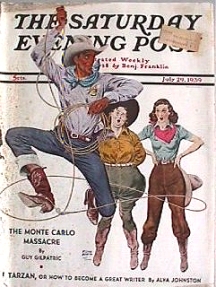
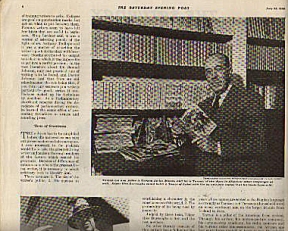
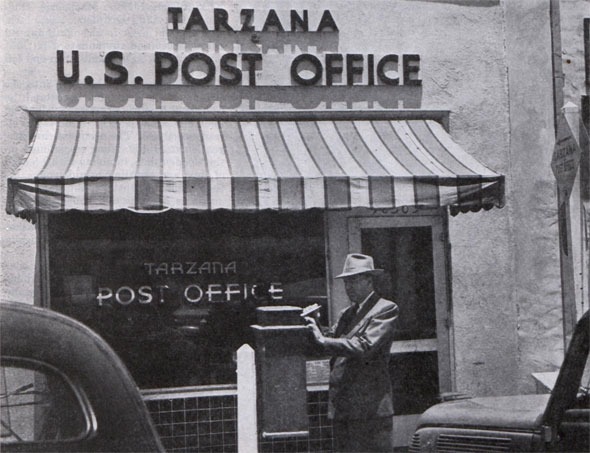
With illustrations and links added by Bill Hillman - ERBzine
Tarzan Gets Slapped
One sequence in Tarzan of the Apes will bear comparison with the much-admired passage in Gulliver's Travels in which the Lilliputians, in an official report on the effects removed from Gulliver's pockets, suggest that his watch is his god because of the frequency with which he consults it. Tarzan sees Kulonga, son of a savage chief, cook a wild boar and eat it. Tarzan knows the fire only as ara, the lightning. He cannot understand why anybody would spoil raw meat by plunging it into fire. He concludes that Kulonga is a friend of the god of lightning and is sharing the wild boar with him. There is occasionally a touch of poetry in Burroughs, as in describing Tarzan's grass-woven lasso as "his long arm of many grasses."Another source of the author's strength is his strong grip of character. Not only Tarzan but the apes and animals are highly individualized beings who seldom step out of character. Burroughs edits the Tarzan movies and newspaper strips to see that no liberties are taken with the Tarzan psychology. In one movie scene, for example, Tarzan threw his head back and laughed long and boisterously. "Strike it out," ordered Burroughs. Tarzan, in spite of his violent activity is as reserved and contemplative as Hamlet. Nothing could be farther from his personality than brainless uproariousness.
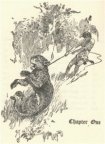
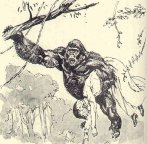
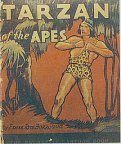
One of the handsome passages in Tarzan of the Apes is the ape-bred boy's first encounter with white womanhood. Tarzan rescued the heroine, a glamorous but educated American girl, from the clutches of a mate-hunting giant ape. The bronzed and sun-baked Tarzan, accustomed to seeing none but ape women and blacks, was conscious of a sudden prejudice in her favor, in spite of her white body. He wanted her to know that he was favorably disposed toward her. His good will took the form of pawing and nuzzling. She slapped him. Tarzan was astonished. He had assumed that, when a member of a species showed a nice spirit toward another member of the same species, that spirit would be reciprocated. He could not understand why she was returning evil for good.Burroughs was told that Kipling liked Tarzan and supposed that Tarzan was patterned after Mowgli of The Jungle Book. According to Burroughs, Tarzan is a literary descendant, not of Mowgli but of Romulus and Remus, who got such a raising from a she-wolf that they founded Rome. Burroughs credits himself with only one stroke of genius -- the naming of Tarzan. The impact of those two syllables on the eardrum is, in his opinion, largely responsible for the world success of the Tarzan books. This is one of the few literary secrets of Burroughs that is communicable. In christening his characters he works with syllables as some composers work with musical notes. He tests one sound against another until, after trying perhaps hundreds of combinations, he has a name that rings like a fire bell.
The Boy Who Escaped Grammar
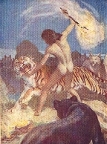
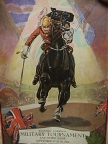


The early life of Burroughs was more interesting than his business career, but it furnishes few hints toward becoming a great writer. His father, who had been a major in the Civil War, grew rich in the distilling business. Later he became a manufacturer of electrical batteries. He had a habit of reading aloud, which partly caused young Edgar's aversion to the literature. When, for example, his father read Dombey and Son, Edgar hated Dombey and had the impression that Dombey and Dickens were one and the same person. When he learned the difference, it was too late for him to overcome his ingrained prejudice against Dickens. He has also cherished a lifelong dislike for Shakespeare, but is big enough to state that he assumes it to be his fault rather than the poet's.Burroughs' escape from grammar was a lucky accident. He was sent to a private school in Chicago which held that the teaching of English grammar was nonsense and that students should absorb grammar through Latin and Greek. Edgar absorbed no Latin and Greek. He was then sent to Phillips Andover, which, assuming that all freshmen were thoroughly drilled in grammar, ignored the subject. Phillips Andover quickly waived on young Burroughs, and he was sent to military academy, which paid no attention to grammar. Edgar thus became an uninhibited writer, free from the anxieties about moods and tenses which kill spontaneity. Burroughs doesn't know whether he is grammatical or not, and cares less. He always writes or dictates at top speed in order to get his thoughts on paper while they are fresh and hot. No grammar-scared writer can do that. Burroughs never makes corrections unless he finds an inconsistency in his development of plot.
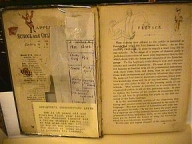
The battery business led the elder Burroughs to become interested in an electrical horseless carriage. Edgar demonstrated it at the World's Fair, in 1893. The only time he ever felt that he amounted to something was when he drove a nine-seater horseless surrey about the fairgrounds, starting runaways every hundred feet or so.
A Youthful Glory Seeker
In his youth Burroughs had a craving for glory. He preferred the military variety because his father had been a soldier. After graduating from the Michigan Military Academy he joined its faculty as a cavalry instructor. After the Sino-Japanese War of 1894-5, China, which had been defeated because her armament consisted largely of drums and dragon banners, started to reorganize her army. Burroughs sought a commission in the Chinese army, but failed. Later he obtained a commission in the Nicaraguan army, but his family interfered. At the age of twenty he enlisted in the Seventh Cavalry and was sent to Arizona against Geronimo. Instead of cavalry charges, however, the campaign consisted mainly of ditch-digging. Wires were pulled, and, because Burroughs had enlisted while under age, he was discharged. In 1898 he volunteered for the Rough Riders, but received a polite letter of regret from Theodore Roosevelt.
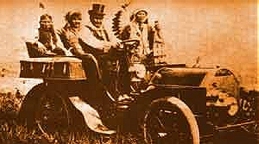
During his brief Regular Army service, Burroughs had committed two grave infractions of the military code. On sentry duty, he was required to shoot to kill if anyone disregarded his warning of "Halt, or I fire." His warning was twice disregarded, but Burroughs did not shoot. In each case he wrongfully saved the life of a drunken member of his own outfit. He escaped disgrace, his unsoldierly conduct never becoming known.From the Army Burroughs went directly into cow handling, and then into gold dredging. Years later, after establishing himself as a writer about imaginary worlds and countries, he wrote The Bandit of Hell's Bend, based on his Western experience. This was a violation of his custom of not writing things personally known to him; but Alexander Grosset of Grosset & Dunlap, pronounced The Bandit of Hell's Bend the greatest Western ever written.

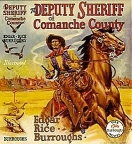
The old craving for glory was roused in Burroughs only once after the Spanish-American War. He happened to see the regal state in which the president of the Oregon Short Line traveled. He took the only railroad job he could get. In hot pursuit of glory, Burroughs chased bums out of boxcars in the Salt Lake City railroad yards for six months. But the idea of becoming a railroad president -- last of his high ambitions-- faded, and he drifted into the business career which punished him until he took refuge in literature.The first Tarzan story did not immediately make Burroughs rich. The idea of bringing it out in book form was rejected by publishing houses, one reason being that they felt that the title, Tarzan of the Apes, would shock refined people. Burroughs wrote a sequel, The Return of Tarzan. It was declined by the Munsey publications, without the knowledge of Bob Davis, editor-in-chief of that organization.


Davis was furious when the Tarzan sequel was printed in a rival magazine. The famous editor took Burroughs under his wing and insisted on publishing everything he wrote. Even Davis, however, did not see the future of Tarzan. He induced Burroughs to cause the original Tarzan to assume his title of Lord Greystoke and take his seat in the House of Lords, while the series was carried on with the son of Tarzan. This caused confusion, and Burroughs finally went back to Tarzan the First. According to rigid rules of biology, the African wild boy is now a grandfather.In less than a year after his first work was published, Burroughs was a big pulp name and a ten-cents-a-word writer. As his literary labor consisted largely of transcribing from memory the old phantasmagorias with which he soothed himself during his business life, his production was large. He was making more than $20,000 a year before his first book was published. On his banner day he wrote 9100 words -- $910 worth.
An International Institution
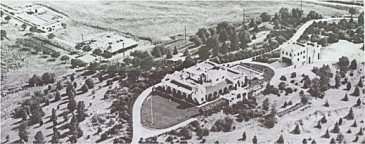
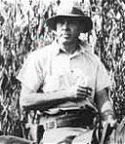
Big money did not immediately soften Burroughs' hatred of modern life. His great aim was to escape from civilization, and, as son as he had money, he went to Southern California. In 1919, after he had become wealthy, Burroughs bought the 600-acre Harrison Gray Otis ranch in the San Fernando Valley and founded the town of Tarzana, about half an hour's auto ride from Hollywood. He delighted to ride, stetson on head, gun across saddle, over his hills and through his valleys and his canyons.He started to ranch on a large scale with pedigreed animals. It was necessary to write furiously to support the ranch. Scarcity of wells and springs was the trouble. Water had to be brought in from the outside. After some experience with water rates, he found it would be cheaper to take his cattle to a soda fountain. The ranch was turned over to the El Caballero Golf Club, which failed. After running it as a public golf course for a while, Burroughs sold out.

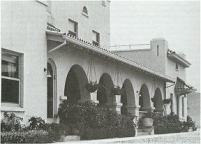
Burroughs had been writing four years before a publishing house would take a chance on printing his novels in book form. The late J. H. Tennant, editor of the New York Evening World, had read Tarzan of the Apes in All-Story and bought the right to print it in his newspaper. Other papers followed suit, and Tarzan fans became an important bloc in the community. A.C. McClurg & Co., one of the many publishers which had previously rejected Tarzan of the Apes, began publishing the Tarzan books and then other Burroughs novels. Millions of boys took to leaping from limb to limb and from tree to tree. The nation resounded with the Tarzan yell and the snapping of collarbones.
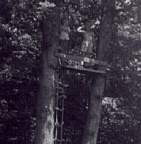
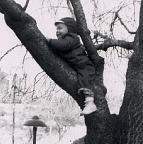
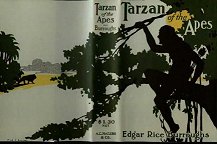
Today Burroughs has forty-nine books in print. The sales have exceeded 30,000,000 copies. The Tarzan books are still in great demand in nearly every part of the world except Germany. In 1925 Burroughs was taking more royalties out of Germany than any foreign author, but in that year a German writer printed a book entitled Tarzan the German Devourer. During the World War, Burroughs had, in Tarzan the Untamed, caused Tarzan to do his bit by capturing German officers and feeding them to lions. The sensitive Teutons boycotted Burroughs after 1925.
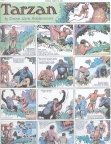
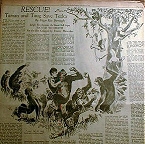
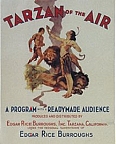
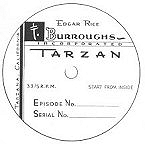
Tarzan is a radio star today. The Tarzan comic strip is printed in about 150 American newspapers and forty foreign ones, including journals in Java and Ceylon. Tarzan has been a great money-maker in the movies for more than twenty years. JohnnyWeissmuller is the ninth actor to play the part in the films.

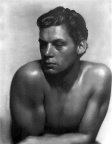
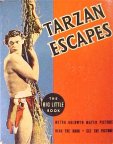
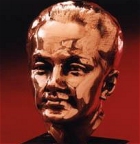

Tarzan's importance in the films increased greatly in 1932, when the late Irving Thalberg took charge of his career. Thalberg and Burroughs agreed that Tarzan pictures should be great spectacles and should come out once a year, like a circus. Thalberg's first two pictures cost more than a million each, and the third, Tarzan Escapes, cost more than a million and a half. After Thalberg's death, the Metro-Goldwyn-Mayer Company dropped Tarzan as too expensive. But the final audit showed that Tarzan Escapes had grossed more than $2,000,000, and the series was resumed.The expensiveness of the Tarzan films lies partly in the nature of things and partly in the maniacal perfectionism of Hollywood. In the last picture, Tarzan Finds a Son, the producers wanted an effect of steam rising from a lake. They ransacked the country for steamy lakes and at last found the one they wanted in Florida. The lake refused to steam for them. They found that it would steam only on certain days and then only for about fifteen minutes in the morning. It took the location company seven days to get the pictures they wanted.
Most of the Tarzan scenes are taken out of doors. Bad weather causes losses running into hundreds of thousands of dollars in salaries of actors, technical men and mobs of extras. But the greatest expense is that of getting animals to perform. In making the last picture a lion cost the company tens of thousands of dollars by refusing to chase a small boy. The lion would either walk or lie down or lope off in the wrong direction. When he finally took after the boy, the boy forgot to run. The pay roll ran wild for ten days before the scene could be shot. Flamingos, zebras and other live items of African background, after hours had been consumed in maneuvering them into their places, walked off the set just before the cameras started.
It took weeks to teach the big elephant, Queenie, to limp when she was supposed to have been shot in the foot. In the meantime the baby elephant Bea, was limping sympathetically, and it took weeks to break her of the habit. A herd of hippopotamuses broke out of their stockade in Sherwood Lake and ate up $25,000 worth of horticulture in the neighborhood. Fresh ostrich eggs, which were used by Tarzan's mate in making omelets, cost twenty-five dollars each.
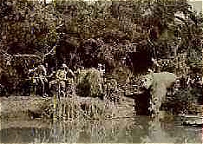
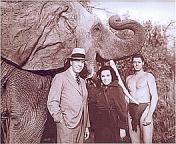
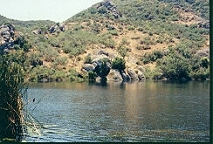
M-G-M spared no expense on the Tarzan yell. Miles of sound track of human, animal and instruments sounds were tested in collecting the ingredients of an unearthly howl. The cry of a mother camel robbed of her young was used until still more mournful sounds were found. A combination of five different sound tracks is used today for the Tarzan yell.
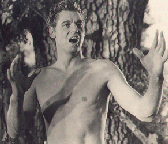
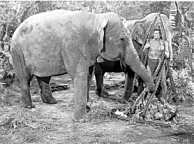

These are:
When the orchestration of the yell was perfected, the five loudspeakers were played simultaneously and the blended sounds recorded on the master sound track. By constant practice Weissmuller is now able to let loose an almost perfect imitation of the sound track.
In some advance publicity on the latest picture, Tarzan Finds a Son, M-G-M let it become known that Tarzan's mate, Jane Porter, was to die. This was an awful tragedy to him. His second best literary property was to be callously abolished by a film company. He looked up his contract. It stipulated that M-G-M could not kill, cripple, or undermine the character of Tarzan, but it was silent as to his mate. Burroughs regarded Tarzan as a fundamental monogamist and would not look forward to building up a new romance around a widower. But shrieks from the fans all over the country changed M-G-M's mind, and Jane's life was spared. The movie company had nothing against Jane, but it was tired of losing the services of Maureen O'Sullivan, who played Jane, during the interminable months while bad weather and perverse animals were delaying Tarzan productions.
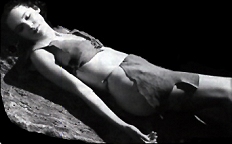
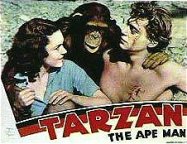

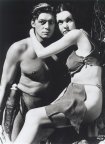
The movie company is sending an expedition to Africa for the next Tarzan picture. It is planned to make the okapi, least seen and known of large animals, a sort of co-star with Johnny Weissmuller.The okapi is a relative of the giraffe and the extinct samotherium. It stands five feet high at the shoulders; its colors are purple an puce; its legs are striped like a zebra's.
Dwelling in dense forests, rendered almost invisible by its coloring, the okapi -- pronounced "okappi" -- is the cameraman's toughest assignment. Burroughs has been asked to accompany the expedition for publicity purposes and is inclined to accept. He began to take a great interest in Africa after writing his first few books about it. He has a library on the subject today and has become a sort of authority on Africa. He would like to see some of the country about which he has written hundreds of thousands of words. Aside from brief excursions to Canada and Mexico and one trip to Hawaii, he has never been out of the United States.
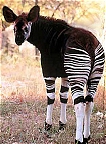

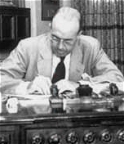
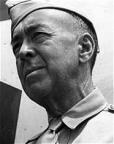
Burroughs is sixty-three years old. He is a little above medium height, and powerfully built. Horseback riding and tennis keep him fairly rugged, but he is always planning more strenuous measures to take off the extra ten pounds.He leads a fairly busy life at his office at Tarzana, where he not only knocks off two novels a year but superintends the publication of his books and other Tarzan enterprises.
The creator of Tarzan has a big poker face surmounted by close cropped iron-gray bristles. He still looks a little military. Interviewers always complain that he does not look literary but it is a convention of the interviewing craft to expect writers to resemble either Robert Louis Stevenson or Irvin S. Cobb.
Portrait of a Realist
There is probably less literary foppery about Burroughs than about any other living writer. He has enough fame for a thousand ordinary lions of the literary teas, but it has never meant anything to him except as it has boosted royalties. He has known few writers personally and does not like them as a class; he thinks they spend their leisure time sitting around and trying pathetically to say smart things.Burroughs travels with a non-Tarzan-reading set. If a personal friend ever tells Burroughs of looking into a Tarzan book, he mentions the matter with an apology or a hearty laugh. "My son," says the friend, "left it lying open on a table and I happened to pick it up. Ha! Ha! Ha! I read a little of it. Ha! Ha! Ha!" If anybody compliments him to his face, Burroughs bristles, supposing that he is being heckled. But he is not mortified to learn that over in Japan little boys have been named Edgar after the author of Tarzan.
In his office at Tarzana, Burroughs has a soundproof study. At first that seems to be in the classic literary tradition. It recalls Carlyle's everlasting campaign to fortify his study against the crowing of the demon fowls. Burroughs, however, soundproofed his study so that he can dictate his novels to a recording machine without disturbing his secretarial staff in the adjoining room.
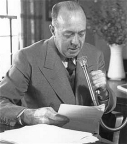
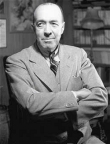
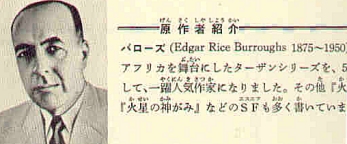
![]()
See the related article from 1966
How To Be A Great Writer
Sunday News, July 17, 1966
Tar Meets Zan, Tar Gets Zan
www.erbzine.com/mag30/3035.html
![]()

![]()
![]()
![]()
Volume
0528

BILL
HILLMAN
Visit
our thousands of other sites at:
BILL
AND SUE-ON HILLMAN ECLECTIC STUDIO
ERB
Text, ERB Images and Tarzan® are ©Edgar Rice Burroughs, Inc.-
All Rights Reserved.
All
Original Work ©1996-2004/2019 by Bill Hillman and/or Contributing
Authors/Owners
No
part of this web site may be reproduced without permission from the respective
owners.